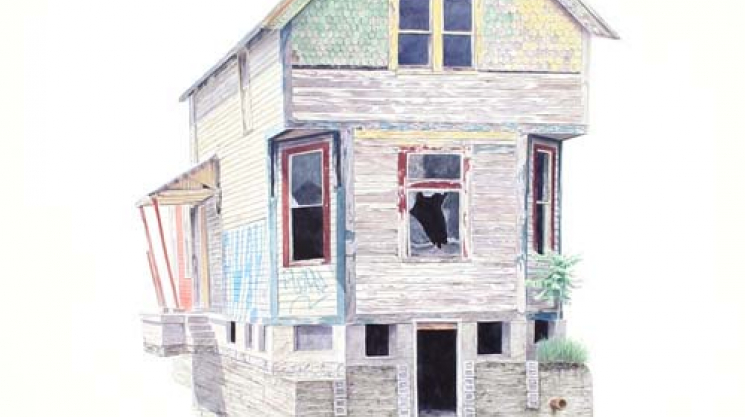
Tue, 05/18/2010 - 00:00 by AltaGrade
The phrase, “Beauty is in the eyes of the beholder” is usually tossed off as an overused cliché. But when it comes to Tristram Lansdowne, it’s not uncommon to have a change of heart. Suddenly, such statements lose their banality once associated with someone so down to earth. This 26-year-old Toronto resident (via Victoria) seeks out the decayed and dilapidated edifices in the outskirts of his town with the intentions of preserving them on canvas in the form of watercolour paintings. Tristram’s work has recently received international attention, as he just wrapped up an exhibition titled Refuge at New York’s Joshua Liner Gallery.According to Tristram, his work is influenced by “visions of the utopian past,” especially since he feels that this optimism for the future is now lost. “I guess every generation has their own doomsayers but, with global warming and all sorts of large-scale problems that seem to be out of our hands, it’s really difficult for our generation to be optimistic about environmental issues. They’re so severe and they’re on such a large scale that it’s hard to engage with them on a personal level. If you look at the way people looked at the future throughout the 20th century there were always huge looming problems but they were perhaps more temporary and there was a possibility of looking at a brighter future.” That being said, Tristram is quick to assert that he doesn’t want to come off as a preacher of his ideas about the future. “What I’m more interested in is engaging with what’s around me directly and seeing what I can do with it and seeing if I can find something beautiful or interesting in what has been tossed aside.” For some, finding beauty in a highly-industrialized city is no easy task, but for Tristram, it quite literally is a walk in the park. His creative process is composed of two main duties. Firstly, he starts by simply exploring his surroundings, which involves a lot of walking and taking a lot of photos. Next, he concentrates on generating ideas or concepts concerning what could be beneath these structures. “So on that premise, when I’m walking around, I keep that in mind and try to look at ways to relate what I’m seeing above ground to what could be underneath. It’s partially what I can discover and find randomly by walking and partly coming up with these formats that I’ve been developing and seeing how they fit together. It’s nice because it’s always a surprise what I find.”
While solitude and natural decay are all emphasized in Tristram’s art, one can’t help but notice the evidence of a human touch found in the paintings. Empty beds, broken windows and walls veiled in graffiti are all stirring indicators of a human presence.
“I think it’s just the way I feel when I wander around some of these areas. There’s a presence of people, it’s everywhere. They’re signs of usage of these areas, and you rarely see anybody and you don’t necessarily want to, they’re just very haunting. Graffiti is a by-product of the areas that I explore now. It’s so prevalent in the places where I take pictures that it’s just an integral part of the landscape. It’s aligned with the organic decay and breaking down of material. It’s sort of a human version of mould. It’s one of the visual signs that a structure has been forgotten or abandoned.”
No longer forgotten, Lansdowne’s paintings have given these neglected structures the attention they have always deserved, even if only on canvas. Hopefully one day you get the chance to keep Tristram’s abandoned buildings company at a future exhibit in your area. On returning to his West Coast stomping grounds, Tristram suggests not to hold your breath. “It takes me so long to get enough paintings together for a show, it could be a couple years.” Considering Tristram’s unique vision, meticulousness and overall passion for his art, it will be worth the wait.




Add comment